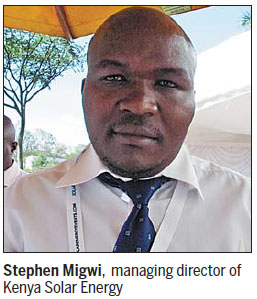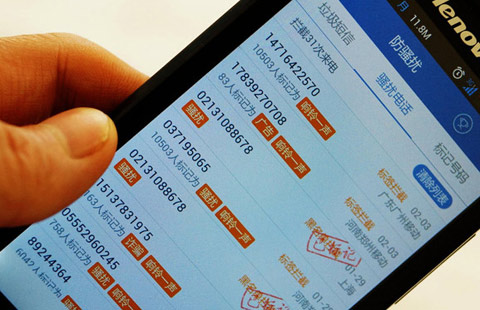
Two power projects in Kenya have highly ambitious commissioning dates
Two government-approved solar projects in Kenya will be financed and built by Chinese companies. The projects will provide a fillip to the government's goal of expanding energy access using clean and modern solutions, project managers say.
The aim is for the power stations to begin generating a total of 80 megawatts of power before the end of the year.
|
A guard stands near a solar panel at the Safaricom Base Transmission Station in Kajiado, 100 km south of Nairobi. Noor Khamis / Reuters |
Given that this is less than 10 months away, that may seem overly ambitious, but the project managers are buoyed by the fact that China has a great record of completing infrastructure projects on time.
"This is where their strength lies - in product innovation and deployment speed," says Bartholomew Simiyu, of Greenmillenia Energy Ltd, which plans to build a solar farm in Isiolo county, about 280 kilometers north of Nairobi.
The county's location in the center of the country makes it a perfect conduit between north and south.
Kenyan solar projects have attracted a lot of interest from Chinese companies. The country's supply of bankable projects is limited compared with the demand, Simiyu says. Several Chinese companies worked with Greenmillenia Energy in the project's development stage, but the company settled for just one of them, whose name he says he is not at liberty to divulge because the matter is confidential. Greenmillenia then received financing of $86 million through China Exim Bank.
"This financial backing sends the right signals to other renewable energy private investors in the country," Simiyu says. "The local banks have been non-committal, leaving the opportunity open for foreign institutions."
With financial backing secured, Kenya's Electricity Regulatory Commission granted Greenmillenia an electricity generating license.
Kenya plans to add 5,000 mW to its national grid over the next three years, and in the process reduce power generating costs by almost 40 percent. In turn, affordable power is meant to promote industrial development and enable the country to realize Vision 2030, its ambitious economic plans.
The World Bank estimates that 28 percent of the country's 40 million people are connected to the grid. Solar is regarded as the most reliable source of energy, but little has been done to harness its potential. Studies done by the regulatory commission indicate that the country receives four to six kilowatt hours of sunshine per square meter a day.
The government's decision to abolish import duties on renewable energy equipment and accessories and to remove the 16 percent value added tax on them has stoked interest in using such power, but at the moment individuals and companies are using only 20 mW, regarded as just a fraction of the potential.

One reason for this is undoubtedly that anyone wanting to obtain a license to generate power has to go through a laborious and time-consuming application process.
Greenmillennia and Kenya Solar Energy, the second government-approved company, say that in addition to this, obtaining information is frustratingly difficult.
The two companies have completed the initial process and are now in talks with the electricity distributor Kenya Power on tariffs. But it may take more than three months for the power purchasing agreement to be finalized. In that time not only will finances be eaten away, but financial and technical backers will be kept waiting, officials say
"It has taken us approximately three years to finally acquire the license to generate and distribute electricity," says Stephen Migwi, managing director of Kenya Solar Energy. "Additional delay impacts deployment time of the project."
In addition, private investors are unhappy with proposed government tariffs for solar energy. Greenmillennia says the $0.12 a kilowatt hour the government agency has fixed is too low, but Migwi says he sees it as reasonable.
"Going by the government's goal of reducing energy costs, it cannot go higher than that," he says.
Another problem both companies have faced is securing local financial backing. Local banks are yet to warm to the sector.
"The local banks offer loans at 15-18 percent," Migwi says. "Looking at the magnitude of the project, it would take more than 10 years to recoup the investment."
Conditions that local banks wanted to place on financing were also more stringent than those that Chinese institutions call for, he says.
In that case, he says, the project managers only needed to produce a 25 percent bank guarantee of total project costs. Under the engineering, procurement and construction parameters of the project, JS Neoplant Company Limited of Hong Kong is financing the Kenya Solar Energy project to be located in the coastal town of Lamu.
Commenting on the ease with which Kenya Solar Energy and JS Neoplant reached a partnership agreement, Migwi says his company has benefited from Chinese expertise.
"At one point they came and assisted us in carrying out a grid analysis study. They were more experienced, and this also saw us cut down on our costs."
Kenya Solar Energy is happy with the engineering procurement and construction deal with the Chinese company, given the difficulty in obtaining solar panels and other parts locally. Kenya lacks the industrial capacity to manufacture photovoltaic panels, so these will be imported from China.
"Most foreign companies also lack the capacity to meet the needs of such a project," Migwi says. "China continues to lead in this."
Closing the gap may take a long time, he says. Given how small Africa's solar market is, it is impractical to set up locally related manufacturing anywhere other than in South Africa in the continent.
"Once one or two projects are complete, perhaps some manufacturer will be convinced of the industry's potential," Migwi says.
He recommends that a solar board be set up in Kenya that would promote, oversee and implement policies aimed at improving the solar energy market. Among other things, it would seek financing, propose quality standards for solar equipment and accessories and conduct public awareness campaigns about technical providers.
The industry has been blighted by cases of poor workmanship, in large part because of a shortage of technicians with extensive knowledge of solar energy know-how. However, more official pressure is now being exerted on companies to employ trained technicians.
A solar board would also need to advise on the way power purchase agreements are framed, Migwi says, to make them more bankable. "Financiers complain and are always asking for them to be revised, saying they are unclear in regards to taxes, and that raises doubts about their being changed in the future. These agreements are just too unpredictable."
To speed up government processes, a one-stop shop should be created, Migwi says. Services from all relevant government agencies could be put under one roof to improve the overall investment climate in energy project development.
Regulations covering solar and wind energy investors also need to be revised to protect producers and consumers, he says.
"Current regulations are biased toward hydro and thermal energy production. Solar and wind are the next big solution for Kenya, but they have not been addressed."
In July 2013 the Energy Regulatory Commission launched a website as an information point offering guidance on licensing and regulatory requirements for renewable energy project development.
Kenya ranks 22nd in Africa for its electricity output and 46th globally.
Lucymorangi@chinadaily.com.cn
(China Daily Africa Weekly 03/20/2015 page8)








